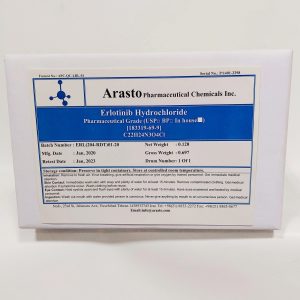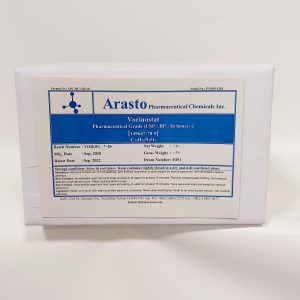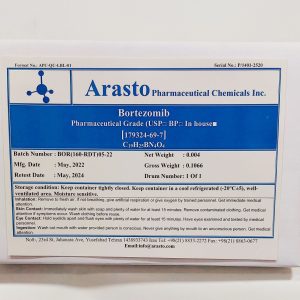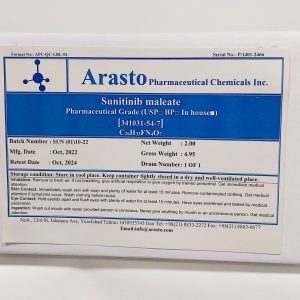Description
Description
(USP 44)
- Drug Substance General Information (ICH 3.2.S.1)
1.1. Nomenclature (ICH 3.2.S.1.1)
International non-proprietary name: Gemcitabine (Brand Name: Gemzar, Eli Lilly, USA)
Compendial name: Gemcitabine
Chemical name: 4-Amino-1-(2-deoxy-2,2-difluoro-β-D-erythro-pentofuranosyl)pyrimidin-2(1H)-on
Arasto’s code: GEM
CAS Registry Number: [95058-81-4]
- Drug Substance General Information (ICH 3.2.S.1)
1.2 Structure (ICH 3.2.S.1.2)

Empirical formula: C9H11F2 N3O4
Molecular Weight: 263.198 g/mol
- Drug Substance General Information (ICH 3.2.S.1)
1.3. General Properties (ICH 3.2.S.1.3)
Gemcitabine is a white crystalline substance. It is soluble in neutral water and most organic solvents. Gemcitabine is used in injectable form for the treatment of ovarian cancer in combination with carboplatin, breast cancer in combination with paclitaxel, non-small cell lung cancer in combination with cisplatin, and pancreatic cancer as a single-agent (http://pi.lilly .com/us/gemzar.pdf). The pKa value of gemcitabine is 3.6 (http://www.drugs. com/mmx/ gemcitabine.html#citec00990002). Like all nucleosides, Gemcitabine undergoes Amadori Rearrangement in strong acid media, but it is relatively stable in weak basic solution (see Stability Studies). LD50 of Gemcitabine has been reported (500 mg/kg, oral rat; 333 mg/kg; oral mouse; > 1000 mg/kg dermal rabbit, http://www.sagentpharma.com/Products/Gemcitabine /Catalog/ Gemcitabine_MSDS.pdf f).
The determination of purity and assay of APIs require comparison of the product with their respective Reference Standards (RS) and Related Compounds (RC or known impurities). Accordingly, ICH regulations on the purity and assay of reference standard and related compounds are clearly defined and must be followed by drug substance and drug product manufacturers.
According to ICH Q7, 11.1 there are 3 types of standards. This is summarized in the following chart and discussed in detail below.

The impurities provided in the following table represent Secondary Reference Standards (SRS) that are prepared in-house by synthesis or by isolation. Each SRS has undergone extensive characterization ( IR, UV, 1HNMR, 13CNMR. Mass Spec) and determination of its purity and assay (HPLC). For specification of the SRS of those products that have a monograph, the SRS is compared with a pharmacopoeia Primary Reference Standard (UV, HPLC retention time). For specification of those products that do not have a monograph (known as House Primary Standard), we compare their UV ε or ג /max , IR major absorptions, 1HNMR d (ppm) , 13 CNMR d (ppm) or HPLC retention time with values reported in the chemical literature for these compounds.
- Primary and Secondary Reference Standard (ICH 3.2.S.5)
5.1. Active Pharmaceutical Ingredient

Primary Reference Standard for gemcitabine is available from United States Pharmacopoeia. We will use a Secondary Reference Standard (previously referred to as Working Standard) for direct control of all batches of gemcitabine.
As per ICH (Q7, 11.1) and ICH (Q6, 2.11, 3.2, 3.3)the Secondary Reference Standards, which include the API and its Related Compounds, must be examined for their proof of structure (characterization), assay and purity and specification (identification by comparison). Furthermore, ICH Guideline on the Preparation of Common Technical Document (Q4M) requires that the data obtained from characterization, assay and purity and specification must be included in section 3.2.S.3.2 for Related Compounds (already discussed in that section) and section 3.2.S.5 of the DMF for the API. To this end, the Secondary Reference Standards of the API gemcitabine has undergone extensive characterization (UV, IR, 1 H NMR, 13C NMR, and Mass Spec) to assure its structure, assay and purity (HPLC and/or titration) and specification (comparison of its HPLC retention time and UV ג /max with USP Primary Reference Standard.
The Secondary Reference Standard for gemcitabine was produced from a released batch of gemcitabine by subjecting it to an additional crystallization from the final solvent system used in the production of the API to avoid the possibility of other polymorph formation.
SPECIFICATION OF ANALYSIS
| Product: Gemcitabine Hydrochloride | CAS No.: 122111-03-9 | Spec. No.: APC-QC-SPEC-206-00 | ||
| Issue Date: Apr, 2023 | Valid up to: Apr, 2024 | Reference: USP44 | ||
| Tests | Specifications | |||
| Description | White to off-white solid. | |||
| Solubility | Soluble in water, slightly soluble in methanol, practically insoluble in alcohol and in polar organic solvents. | |||
| Identification | A: Infrared Spectroscopy B: Chloride C: The retention time of the major peak of the Sample solution corresponds to that of the Standard solution, as obtained in the Assay. | |||
| Specific Rotation | +43.0º to +50.0° (solution of 10 mg / mL in water at 20°C) | |||
| pH | 2.0 to 3.0 (solution of 10 mg / mL in water) | |||
| Residue on ignition | NMT 0.1% | |||
| Residual solvents | Methanol: Max. 3000 ppm (Class II) Acetone: Max. 5000ppm (Class III) | |||
| Organic impurities (HPLC) | Cytosine: NMT 0.1% Gemcitabine α anomer: NMT 0.1% Any individual unspecified impurity: NMT 0.1% Total impurities: NMT 0.2% | |||
| Assay (HPLC) | 97.5% to 101.5% (on the as-is basis) | |||
| Bacterial Endotoxins | NMT 0.05 USP Endotoxin Unit/mg of gemcitabine. | |||
| Sterility test | Sterile | |||
| Prepared by: M. Shahbazi, B.Sc.Chem. | Checked by: A. Forghani, B.Sc.Chem. | |||
| Approved by: F. Javadizadeh, M.Sc.Chem. | ||||
| Storage: Preserve in tight containers. | ||||





